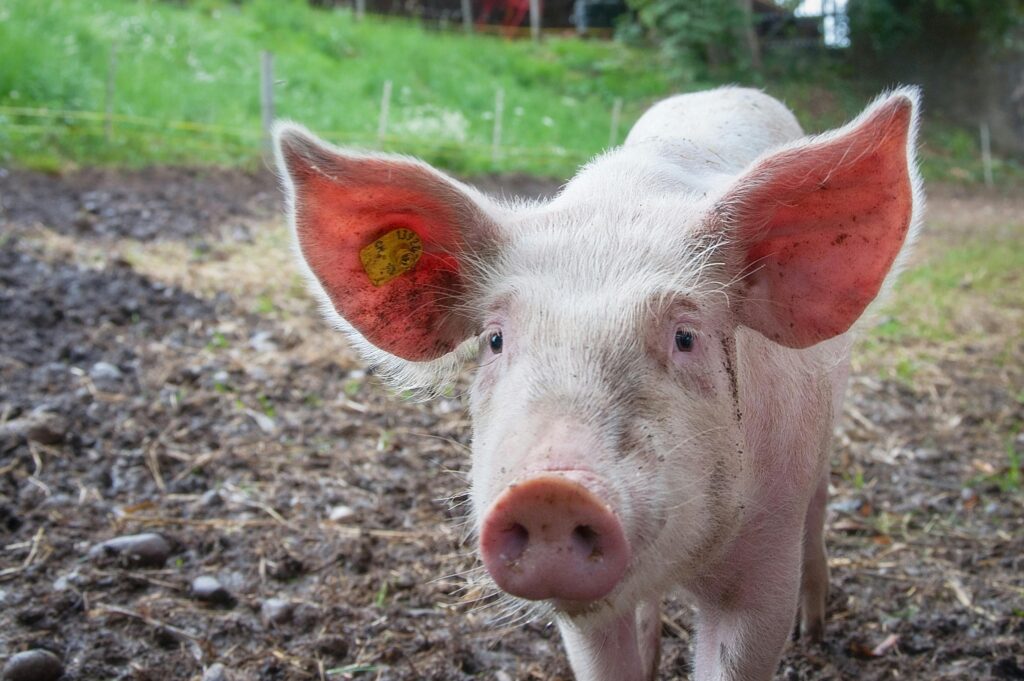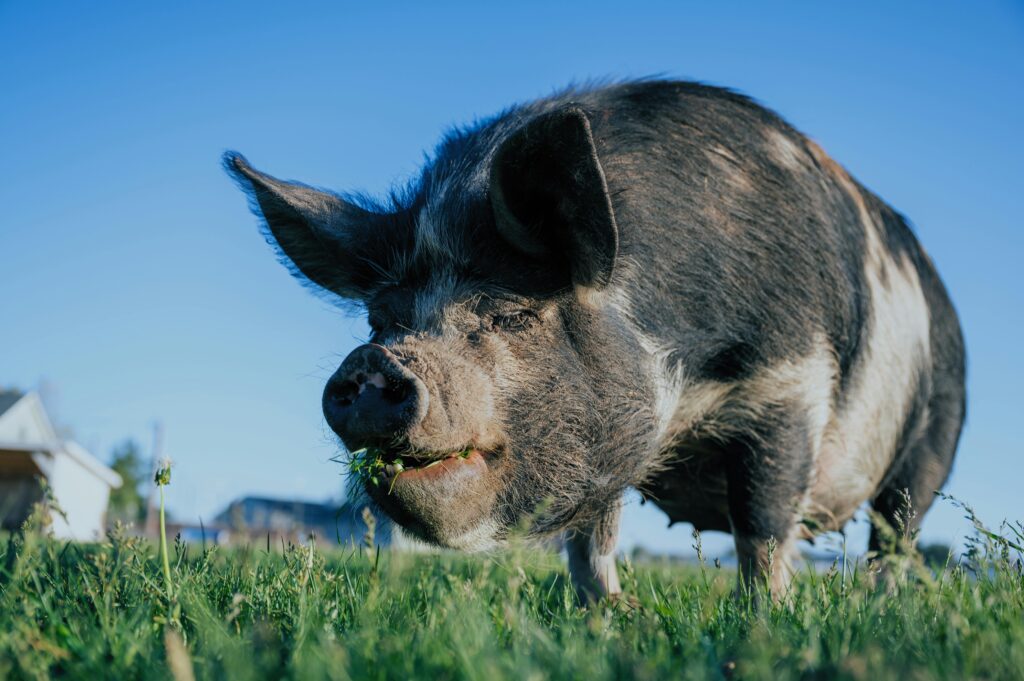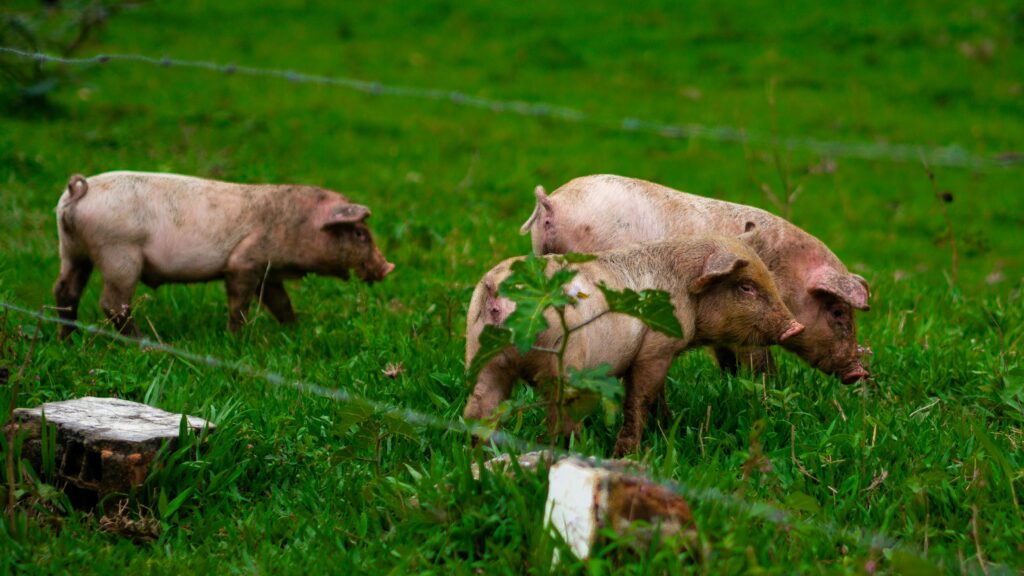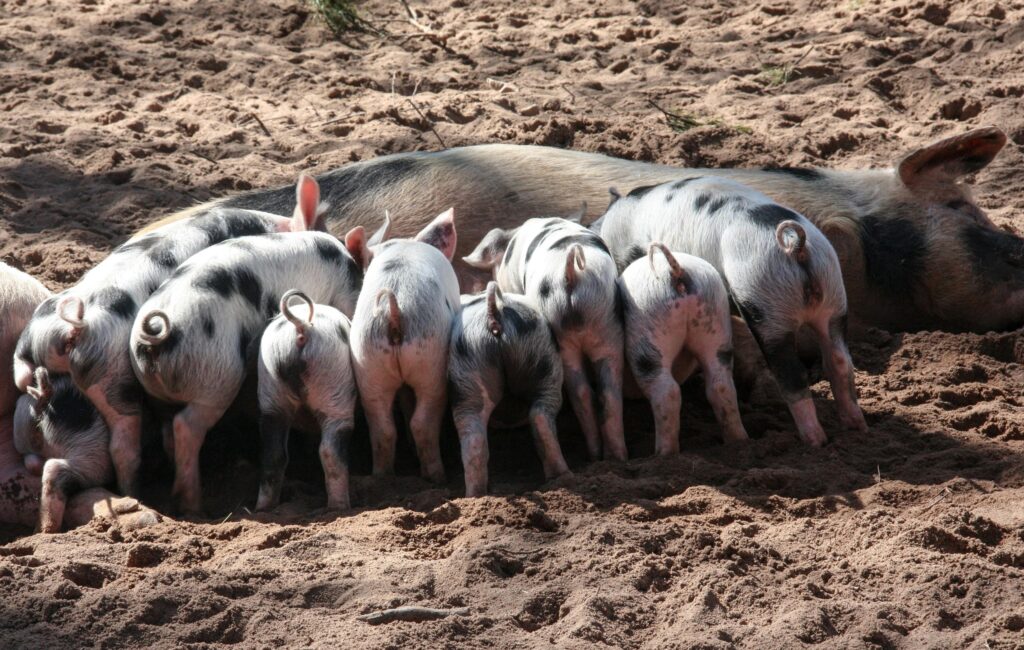Farming & Breeding Pigs for Self-Sufficiency
Keeping pigs can be a highly rewarding endeavor, providing meat, fat, and other by-products while contributing to the sustainability of a self-sufficient farm or homestead. Pigs are efficient converters of feed and can thrive on food scraps and surplus crops, making them an ideal addition to a self-sufficiency plan. This guide will provide you with an in-depth look into raising pigs in Australia, focusing on the best practices, different pig breeds, and what’s required to grow them successfully on your property.

Why Farm Pigs?
Pigs are versatile animals that can serve various purposes on a self-sufficient farm. The reasons for raising pigs go beyond their well-known role as a source of pork for consumption. Here’s a breakdown of why pigs are a great addition to a self-sufficient farm:
Human Consumption
The primary reason for raising pigs is for meat. Pork is one of the most widely consumed meats in Australia, and home-raised pigs can provide a reliable supply of fresh pork, bacon, ham, and sausages. You can also sell or trade surplus pork to local markets, ensuring a stream of income if you want to scale up.
Breeding for Profit
If you plan to scale your operation, pigs can be bred to produce piglets, which can be sold to other farmers or individuals. Depending on the breed, you can sell piglets for a premium, especially if you focus on rare or heritage breeds that are in demand.
Waste Recycling and Land Management
Pigs are excellent at turning food scraps into food. They can eat a wide variety of foods, including vegetable scraps, fruit peels, and some grains. Their rooting behavior also helps aerate the soil and can be beneficial for pasture and land management. They are excellent for clearing land and controlling unwanted vegetation.
Types of Pigs for Farming and Self-Sufficiency
When choosing the right breed for your farm, it’s important to consider your primary goals, whether that’s meat production, breeding, or land management. The breed you select will depend on factors such as climate, feed availability, and the amount of space you can provide.
Large White
The Large White is a popular breed in commercial pig farming in Australia due to its excellent growth rates, hardiness, and ability to produce lean meat. They are often used in crossbreeding programs to enhance the size and growth potential of piglets.
- Best For: Commercial production and meat supply.
- Suitability for Self-Sufficiency: Excellent for farms looking to raise pigs for both breeding and meat production. They grow quickly and yield a high amount of pork.
Landrace
The Landrace is another breed commonly used in Australia, known for its ability to produce large litters. This breed is particularly prized for its reproductive performance and is commonly used for breeding purposes.
- Best For: Breeding programs and meat production.
- Suitability for Self-Sufficiency: Ideal for homesteaders looking to breed their own pigs and raise them for pork. They do well in a variety of climates.
Berkshire
Berkshire pigs are a heritage breed known for their tender and flavorful meat. They are slower-growing than commercial breeds but are highly prized for their marbling, which results in delicious pork cuts.
- Best For: High-quality meat production.
- Suitability for Self-Sufficiency: If your goal is to produce premium pork for consumption or sale, Berkshire pigs are an excellent choice. They require more time and care to reach slaughter weight but can provide top-tier pork.

Tamworth
The Tamworth pig is another heritage breed known for its excellent bacon quality. It is well suited to outdoor farming and can handle Australia’s more temperate climates, particularly in the cooler regions.
- Best For: Premium bacon and ham production.
- Suitability for Self-Sufficiency: If you’re looking to produce specialty products like bacon or cured meats, the Tamworth pig is a great option. It thrives in free-range systems and does well in cooler, temperate climates.
Wessex Saddleback
This hardy breed is known for its resilience in outdoor systems and can thrive in less-than-ideal conditions. Wessex Saddlebacks are often used in breeding programs but are also valued for their flavorful meat.
- Best For: Breeding and meat production, especially in rugged conditions.
- Suitability for Self-Sufficiency: This breed is ideal for homesteaders who want a hardy, low-maintenance breed that can also provide high-quality meat.
Housing and Shelter Requirements for Farming Pigs
Pigs need shelter, but they do not require elaborate buildings. The key to good pig housing is to ensure protection from extreme weather conditions and to provide enough space for the pigs to move freely. Proper shelter will help maintain pig health and support their natural behavior, such as rooting and wallowing.
Basic Shelter Design
- Size: Pigs need ample space to move around comfortably. For adult pigs, a minimum of 3 square meters per pig is recommended. If you’re raising piglets, this area should be slightly smaller.
- Structure: The shelter should have a solid, waterproof roof and walls to protect from rain and wind. Ensure proper ventilation but avoid drafts that can lead to respiratory problems.
- Bedding: Straw, wood chips, or sawdust work well as bedding to absorb waste and provide comfort. This bedding should be kept clean and replaced regularly.
- Wallowing Area: Pigs love to wallow to cool down, especially in hot weather. A mud pit or a shallow pond is a great addition to your pig pen. Make sure it’s easily accessible to the pigs, especially during the warmer months.
Fencing
Pigs are strong and resourceful animals, capable of rooting under or pushing through weak fencing. Strong, durable fencing is essential to keep your pigs contained. Electric fencing is a popular and effective solution for pig enclosures in Australia, especially when dealing with larger pigs.
- Height and Strength: The fence should be at least 1.2 meters high to prevent pigs from escaping.
- Burrowing Prevention: Pigs will often try to burrow under fences. You can prevent this by using fencing that goes at least 30-40 cm underground or by installing a buried wire.

Feed and Water Requirements for farming pigs
Pigs are omnivores and can eat a wide variety of foods. However, to ensure healthy growth and optimal production, they need a balanced diet.
Diet Composition
- Commercial Feed: For faster growth, you may want to feed your pigs a high-quality commercial feed designed specifically for pigs. These feeds contain a balanced combination of protein, vitamins, and minerals.
- Grain: Pigs enjoy eating grains such as corn, oats, and barley. Grains should form a significant portion of their diet, especially for growing pigs.
- Vegetable Scraps: Pigs are excellent at converting food waste into usable energy. You can feed them vegetable scraps, but avoid feeding them meat scraps, as this can lead to diseases.
- Pasture: If you’re raising pigs in a pasture-based system, they will supplement their diet with forage like grass and weeds. Pigs can be rotationally grazed to improve pasture health.
- Water: Fresh water should always be available to pigs, as they drink large amounts daily, particularly in warmer climates. Make sure their water supply is clean and plentiful.
Land Size and Space Requirements for farming pigs
The amount of land you need for pigs depends on the breed, the farming method, and how many pigs you plan to raise. Generally, pigs need space to roam and root, which helps them stay healthy and reduce stress.
Stocking Density
As a rule of thumb, each pig should have access to at least 0.5-1 hectare of land, especially if you plan to use free-range or pasture-based systems. This amount of space will allow them to roam, root, and graze while minimizing environmental degradation. For intensive systems, the density can be higher, but pigs in these conditions require more management and care.
Farming Method
- Pasture-Based Systems: In these systems, pigs are allowed to roam free over large areas of land. Rotational grazing methods can be used to ensure pastures regenerate and prevent overgrazing.
- Intensive Systems: If you’re raising pigs in smaller pens, you will need to provide more intensive care in terms of feeding, waste management, and disease control.

Breeding Pigs for Self-Sufficiency
Breeding pigs can be an important part of maintaining a self-sufficient operation. If you want to keep a consistent supply of piglets for consumption or sale, understanding the basics of pig breeding is crucial.
When to Breed Pigs
- Mating Age: Sows typically reach sexual maturity between 5-8 months of age, but it’s generally recommended to wait until they’re closer to 12-14 months before breeding to ensure they’re fully grown and healthy.
- Breeding Cycle: The estrous cycle in pigs lasts about 21 days, with the sow being in heat for 2-3 days. Sows should be bred once every 6-7 months.
- Boars: A mature boar can breed with multiple sows during a mating season. However, be cautious not to overuse a single boar to prevent inbreeding and maintain genetic diversity.
Gestation and Farrowing
- Gestation Period: The typical gestation period for pigs is about 114 days (3 months, 3 weeks, and 3 days).
- Farrowing Pens: A farrowing pen is crucial for the health of the sow and her piglets. The pen should be clean, dry, and spacious enough for the sow to lie comfortably and for the piglets to nurse. It should also include a heat source for the piglets, as they cannot regulate their body temperature effectively during the first few days of life.
Weaning
- Weaning Age: Piglets can be weaned from their mother at around 6-8 weeks, although some homesteaders prefer to allow them to stay with the sow longer. Weaning too early can stress the piglets and result in poor growth.
- Transition to Solid Feed: As piglets are weaned, they should gradually transition from milk to solid food. Start by offering a mix of grains and fresh greens before introducing more complex feeds.

Health and Disease Management
Maintaining the health of your pigs is essential for long-term success. Like all livestock, pigs are susceptible to a variety of diseases, but with proper management practices, many health issues can be prevented.
Common Diseases in Pigs
- Swine Influenza: A respiratory disease that can spread quickly among pigs, often leading to fever, coughing, and difficulty breathing.
- Gastrointestinal Issues: Pigs can suffer from gastrointestinal diseases such as dysentery or worms. Routine deworming and maintaining proper hygiene can help prevent these issues.
- Foot and Mouth Disease: Although rare, foot and mouth disease can severely impact pig populations. Ensure that your farm follows biosecurity measures to prevent outbreaks.
Prevention and Vaccination
- Vaccinations: Some vaccines are available for diseases like swine fever, parvovirus, and leptospirosis. It’s important to consult with a local veterinarian to create a vaccination schedule that fits the needs of your herd.
- Parasite Control: Regular deworming should be part of your pig care routine, especially in free-range systems. Consult a vet to determine the appropriate schedule and treatment plan for your pigs.
- Biosecurity: Limiting contact with other farms, sanitizing equipment, and practicing good hygiene can help prevent the introduction of diseases to your pig population.
Pig Waste Management
Pigs produce a significant amount of waste, which must be managed properly to avoid polluting your land or water sources. Efficient waste management can also provide opportunities for creating fertilizers or compost.
Manure Management
- Composting: Composting pig manure can reduce odors and turn waste into nutrient-rich compost, which can be used to fertilize crops or pastures.
- Bedding: Straw, sawdust, or wood chips used for bedding can be mixed with manure and composted. This helps reduce waste and keeps the pigpens dry and comfortable.
- Land Application: If you have a large enough area of land, manure can be spread over fields or pastures as a natural fertilizer, enriching the soil with nitrogen and other essential nutrients.
Odour Control
- Odour Reduction: Odour can become a problem in confined pig farming systems. To control this, regular cleaning of pens and waste areas is vital. Using absorbent bedding materials and maintaining good ventilation can also help minimize smells.
- Waste-to-Energy Systems: On larger-scale operations, waste-to-energy systems such as biogas generators can be used to convert manure into usable energy, reducing both waste and energy costs.
Estimated Costs of Farming Pigs
When budgeting for pig farming, there are several factors to consider, including initial investment, ongoing costs for feed and care, and potential profits from meat or breeding sales.
Initial Costs
- Breeding Stock: The cost of buying breeding stock can vary depending on the breed and age of the pigs. Expect to pay more for purebred or heritage pigs than for commercial breeds.
- Infrastructure: Setting up appropriate shelters, fencing, and farrowing pens can be a significant upfront cost. However, this is a one-time investment that will last for many years.
- Equipment: Equipment costs for feeding, watering, and waste management should also be accounted for. Additionally, you may need veterinary supplies and health-related products like vaccinations or dewormers.
Ongoing Costs
- Feed: Feeding your pigs is one of the most significant ongoing costs. The cost of feed will depend on the number of pigs, the breed, and the type of feed you provide. On average, it costs around $100 to $200 per month to feed a pig.
- Healthcare: Routine veterinary visits, vaccinations, and medication will incur ongoing costs. These costs vary depending on the health of your pigs and the frequency of treatments needed.
- Labor: If you’re running a larger farm, labor costs will be a factor. However, for a small homestead, you can likely manage the pigs yourself or with minimal outside help.
Potential Profits
- Selling Pork: Selling pork, bacon, or sausages can generate a significant income, especially if you focus on high-quality or organic meats.
- Selling Piglets: If you are breeding pigs, you can sell piglets to other homesteaders, small-scale farmers, or commercial operations. The price of piglets varies by breed and market demand.
Regional Considerations for Pig Farming in Australia
Australia’s climate varies greatly, and the region in which you farm will impact the type of pig breeds and the infrastructure you need to support them.
Southern Australia
- Cooler Climates: Breeds like the Tamworth and Berkshire do well in the cooler climates of southern Australia. They are well-suited to the temperate regions, such as Victoria, Tasmania, and southern New South Wales, where the cooler temperatures can help pigs thrive without the stress of excessive heat.
Northern Australia
- Warmer Climates: In the northern parts of Australia, where the climate is hotter and more humid, pigs like the Wessex Saddleback, which is more heat-tolerant, may be a better choice. Pigs in these areas will need adequate access to shade and water to prevent heat stress.
Keeping pigs in Australia can be a profitable and sustainable choice for homesteaders looking to become more self-sufficient. By selecting the right breed, building appropriate shelters, providing balanced nutrition, and implementing effective waste management practices, you can create a healthy and productive pig farming system. The key to success lies in careful planning, continuous learning, and adapting your farming methods to suit the local environment and market demand.
